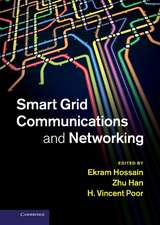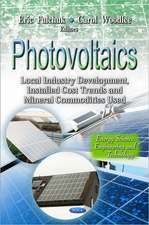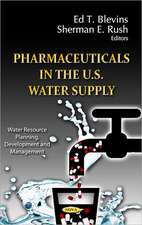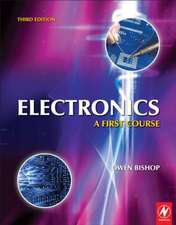Quantum Optics with Semiconductor Nanostructures: Woodhead Publishing Series in Electronic and Optical Materials
Editat de Frank Jahnkeen Limba Engleză Paperback – 18 aug 2016
- A key guide to the theory, experimental realisation, and future potential of semiconductor nanostructures in the exploration of quantum optics
- Chapters provide a comprehensive overview of single quantum dot systems, nanolasers with quantum dot emitters, and light-matter interaction in semiconductor nanostructures
- Explores all-solid-state quantum optics, crystal nanobeam cavities and quantum-dot microcavity systems, and investigates ultrafast phenomena
Din seria Woodhead Publishing Series in Electronic and Optical Materials
- 24%
 Preț: 1160.66 lei
Preț: 1160.66 lei - 18%
 Preț: 1299.95 lei
Preț: 1299.95 lei - 39%
 Preț: 1136.44 lei
Preț: 1136.44 lei - 9%
 Preț: 912.54 lei
Preț: 912.54 lei - 9%
 Preț: 956.68 lei
Preț: 956.68 lei - 24%
 Preț: 951.04 lei
Preț: 951.04 lei - 9%
 Preț: 1335.64 lei
Preț: 1335.64 lei - 29%
 Preț: 986.78 lei
Preț: 986.78 lei - 24%
 Preț: 874.56 lei
Preț: 874.56 lei - 29%
 Preț: 1075.95 lei
Preț: 1075.95 lei - 29%
 Preț: 1414.77 lei
Preț: 1414.77 lei - 9%
 Preț: 1216.61 lei
Preț: 1216.61 lei - 39%
 Preț: 811.62 lei
Preț: 811.62 lei - 29%
 Preț: 1193.77 lei
Preț: 1193.77 lei - 9%
 Preț: 1444.32 lei
Preț: 1444.32 lei - 24%
 Preț: 926.89 lei
Preț: 926.89 lei - 9%
 Preț: 1107.16 lei
Preț: 1107.16 lei - 9%
 Preț: 1262.45 lei
Preț: 1262.45 lei - 9%
 Preț: 954.69 lei
Preț: 954.69 lei - 9%
 Preț: 1006.73 lei
Preț: 1006.73 lei - 9%
 Preț: 958.65 lei
Preț: 958.65 lei - 9%
 Preț: 948.72 lei
Preț: 948.72 lei - 9%
 Preț: 1150.61 lei
Preț: 1150.61 lei - 23%
 Preț: 1493.72 lei
Preț: 1493.72 lei - 9%
 Preț: 950.94 lei
Preț: 950.94 lei - 24%
 Preț: 1276.29 lei
Preț: 1276.29 lei - 29%
 Preț: 1333.73 lei
Preț: 1333.73 lei - 9%
 Preț: 901.22 lei
Preț: 901.22 lei - 9%
 Preț: 1130.18 lei
Preț: 1130.18 lei - 9%
 Preț: 1049.49 lei
Preț: 1049.49 lei - 24%
 Preț: 871.12 lei
Preț: 871.12 lei - 27%
 Preț: 1459.23 lei
Preț: 1459.23 lei - 20%
 Preț: 1071.49 lei
Preț: 1071.49 lei - 24%
 Preț: 932.11 lei
Preț: 932.11 lei - 29%
 Preț: 1071.64 lei
Preț: 1071.64 lei - 24%
 Preț: 670.36 lei
Preț: 670.36 lei - 9%
 Preț: 926.48 lei
Preț: 926.48 lei - 23%
 Preț: 929.43 lei
Preț: 929.43 lei - 9%
 Preț: 897.50 lei
Preț: 897.50 lei - 9%
 Preț: 1276.81 lei
Preț: 1276.81 lei - 9%
 Preț: 957.63 lei
Preț: 957.63 lei - 29%
 Preț: 845.10 lei
Preț: 845.10 lei - 9%
 Preț: 953.05 lei
Preț: 953.05 lei - 33%
 Preț: 1126.67 lei
Preț: 1126.67 lei - 29%
 Preț: 954.77 lei
Preț: 954.77 lei - 24%
 Preț: 961.16 lei
Preț: 961.16 lei - 23%
 Preț: 930.29 lei
Preț: 930.29 lei - 23%
 Preț: 1080.19 lei
Preț: 1080.19 lei
Preț: 1591.78 lei
Preț vechi: 2180.52 lei
-27% Nou
Puncte Express: 2388
Preț estimativ în valută:
304.63€ • 316.86$ • 251.49£
304.63€ • 316.86$ • 251.49£
Carte tipărită la comandă
Livrare economică 14-28 aprilie
Preluare comenzi: 021 569.72.76
Specificații
ISBN-13: 9780081016442
ISBN-10: 0081016441
Pagini: 602
Dimensiuni: 156 x 234 x 31 mm
Greutate: 0.84 kg
Editura: ELSEVIER SCIENCE
Seria Woodhead Publishing Series in Electronic and Optical Materials
ISBN-10: 0081016441
Pagini: 602
Dimensiuni: 156 x 234 x 31 mm
Greutate: 0.84 kg
Editura: ELSEVIER SCIENCE
Seria Woodhead Publishing Series in Electronic and Optical Materials
Cuprins
Contributor contact details
Woodhead Publishing Series in Electronic and Optical Materials
Preface
Part I: Single quantum dot systems
Chapter 1: Resonance fluorescence emission from single semiconductor quantum dots coupled to high-quality microcavities
Abstract
1.1 Introduction
1.2 Emitter state preparation in single semiconductor quantum dots: role of dephasing
1.3 Resonance fluorescence from a single semiconductor quantum dot
1.4 Dephasing of Mollow triplet sideband emission from a quantum dot in a microcavity
1.5 The phenomenon of non-resonant quantum dot-cavity coupling
1.6 Conclusion
1.7 Acknowledgments
Chapter 2: Quantum optics with single quantum dots in photonic crystal cavities
Abstract:
2.1 Introduction
2.2 Integrated, solid-state quantum optics platform: InAs quantum dots (QDs) and photonic crystal nanocavities
2.3 Photon blockade and photon-assisted tunneling
2.4 Fast, electrical control of a single quantum dot-cavity system
2.5 Phonon-mediated off-resonant interaction in a quantum dot-cavity system
2.6 Quantum photonic interfaces between InAs quantum dots and telecom wavelengths
2.7 Future trends and conclusions
2.8 Acknowledgments
Chapter 3: Modeling single quantum dots in microcavities
Abstract:
3.1 Introduction
3.2 Building blocks of the coupled microcavity-quantum dot system
3.3 Theoretical description of the single-quantum dot–microcavity system
3.4 Numerical methods and characteristic quantities
3.5 Competing electronic configurations and input/output characteristics of a single-quantum dot laser
3.6 Sources of dephasing and spectral linewidths
3.7 Analogy to the two-level system
3.8 Conclusions
Part II: Nanolasers with quantum dot emitters
Chapter 4: Highly efficient quantum dot micropillar lasers
Abstract:
4.1 Introduction
4.2 Theoretical description of high-β microlasers
4.3 Fabrication of quantum dot (QD) micropillar lasers
4.4 Optical characterization and pre-selection of QD micropillars for lasing studies
4.5 Lasing in optically pumped QD micropillar lasers
4.6 Lasing in electrically pumped QD micropillar lasers
4.7 Future trends and conclusions
4.8 Acknowledgments
Chapter 5: Photon correlations in semiconductor nanostructures
Abstract:
5.1 Introduction
5.2 Theoretical description of light-matter coupling
5.3 Photon statistics
5.4 Experimental approaches to photon correlation measurements
5.5 Correlation measurements on semiconductor nanostructures
5.6 Future trends and conclusions
Chapter 6: Emission properties of photonic crystal nanolasers
Abstract
6.1 Introduction
6.2 Design of photonic crystal (PC) nanocavities
6.3 Optical emission properties of quantum dots (QDs) in PC nanocavities
6.4 Signatures of lasing in PC nanolasers
6.5 Detuning experiments: the quest for the gain mechanism
6.6 Conclusions
6.7 Acknowledgments
Chapter 7: Deformed wavelength-scale microdisk lasers with quantum dot emitters
Abstract:
7 1 Introduction
7.2 Ray-wave correspondence in microdisk cavities
7.3 Modified ray-wave correspondence in wavelength-scale cavities
7.4 Wavelength-scale asymmetric resonant microcavity lasers
7.5 Conclusions
7.6 Acknowledgment
Part III: Light-matter interaction in semiconductor nanostructures
Chapter 8: Photon statistics and entanglement in phonon-assisted quantum light emission from semiconductor quantum dots
Abstract:
8.1 Introduction
8.2 Incoherently driven emission: phonon-assisted single quantum dot luminescence
8.3 Entanglement analysis of a quantum dot biexciton cascade
8.4 Coherently driven emission
8.5 Equations of motion
8.6 Emission dynamics
8.7 Emission from strongly coupled quantum dot cavity quantum electrodynamics
8.8 Phonon-assisted polariton signatures
8.9 Phonon-enhanced antibunching
8.10 Conclusions
Chapter 9: Luminescence spectra of quantum dots in microcavities
Abstract:
9.1 Introduction
9.2 The Jaynes–Cummings model
9.3 Luminescence spectra
9.4 Experimental implementations and observations
9.5 Luminescence spectra in the nonlinear regime
9.6 Effects of pure dephasing
9.7 Lasing
9.8 Conclusions and future trends
9.9 Acknowledgements
Chapter 10: Photoluminescence from a quantum dot-cavity system
Abstract:
10.1 Introduction: solid-state cavity quantum electrodynamics (CQED) systems with quantum dots (QDs)
10.2 Cavity feeding: influence of multiexcitonic states at large detuning
10.3 Model for a QD-cavity system
10.4 Radiative processes revisited
10.5 Cavity feeding: Monte Carlo model
10.6 Cavity feeding: influence of acoustic phonons at small detuning
10.7 Conclusions
10.8 Acknowledgements
Chapter 11: Quantum optics with quantum-dot and quantum-well systems
Abstract:
11.1 Introduction
11.2 Quantum-optical correlations
11.3 Quantum emission of strong-coupling quantum dots
11.4 Quantum-optical spectroscopy
11.5 Future trends and conclusions
Part IV: Semiconductor cavity quantum electrodynamics (QED)
Chapter 12: All-solid-state quantum optics employing quantum dots in photonic crystals
Abstract:
12.1 Introduction
12.2 Light-matter interaction in photonic crystals
12.3 Disordered photonic crystal waveguides
12.4 Cavity quantum electrodynamics in disordered photonic crystal waveguides
12.5 Future trends and conclusions
12.6 Acknowledgments
Chapter 13: One-dimensional photonic crystal nanobeam cavities
Abstract:
13.1 Introduction
13.2 Design, fabrication and computation
13.3 Passive photonic crystal cavity measurement technique
13.4 Atomic layer deposition (ALD) technique and history
13.5 Experimental results of ALD coated photonic crystal nanobeam cavities
13.6 Conclusions
13.7 Future trends
13.8 Acknowledgments
Chapter 14: Growth of II–VI and III-nitride quantum-dot microcavity systems
Abstract:
14.1 Introduction
14.2 Growth of II–VI quantum dots: CdSe and CdTe
14.3 II–VI Bragg reflectors lattice matched to GaAs and ZnTe
14.4 Microcavities containing CdSe or CdTe quantum dots
14.5 Formation of InGaN quantum dots
14.6 Nitride-based Bragg reflectors
14.7 Microcavities containing InGaN quantum dots
14.8 Preparation of micropillars employing focused ion beam etching
14.9 Conclusions
Part V: Ultrafast phenomena
Chapter 15: Femtosecond quantum optics with semiconductor nanostructures
Abstract:
15.1 Introduction
15.2 Few-fermion dynamics and single-photon gain in a semiconductor quantum dot
15.3 Nanophotonic structures for increased light-matter interaction
15.4 Ultrastrong light-matter coupling and sub-cycle switching: towards non-adiabatic quantum electrodynamics
15.5 Ultrabroadband terahertz technology – watching light oscillate
15.6 Intersubband-cavity polaritons – non-adiabatic switching of ultrastrong coupling
Chapter 16: Coherent optoelectronics with quantum dots
Abstract:
16.1 Introduction
16.2 Single quantum dot photodiodes
16.3 Exciton qubits in photodiodes
16.4 Coherent manipulation of the exciton
16.5 Ramsey fringes: control of the qubit phase
16.6 Coherent control by optoelectronic manipulation
16.7 Future trends and conclusions
16.8 Acknowledgements
Index
Woodhead Publishing Series in Electronic and Optical Materials
Preface
Part I: Single quantum dot systems
Chapter 1: Resonance fluorescence emission from single semiconductor quantum dots coupled to high-quality microcavities
Abstract
1.1 Introduction
1.2 Emitter state preparation in single semiconductor quantum dots: role of dephasing
1.3 Resonance fluorescence from a single semiconductor quantum dot
1.4 Dephasing of Mollow triplet sideband emission from a quantum dot in a microcavity
1.5 The phenomenon of non-resonant quantum dot-cavity coupling
1.6 Conclusion
1.7 Acknowledgments
Chapter 2: Quantum optics with single quantum dots in photonic crystal cavities
Abstract:
2.1 Introduction
2.2 Integrated, solid-state quantum optics platform: InAs quantum dots (QDs) and photonic crystal nanocavities
2.3 Photon blockade and photon-assisted tunneling
2.4 Fast, electrical control of a single quantum dot-cavity system
2.5 Phonon-mediated off-resonant interaction in a quantum dot-cavity system
2.6 Quantum photonic interfaces between InAs quantum dots and telecom wavelengths
2.7 Future trends and conclusions
2.8 Acknowledgments
Chapter 3: Modeling single quantum dots in microcavities
Abstract:
3.1 Introduction
3.2 Building blocks of the coupled microcavity-quantum dot system
3.3 Theoretical description of the single-quantum dot–microcavity system
3.4 Numerical methods and characteristic quantities
3.5 Competing electronic configurations and input/output characteristics of a single-quantum dot laser
3.6 Sources of dephasing and spectral linewidths
3.7 Analogy to the two-level system
3.8 Conclusions
Part II: Nanolasers with quantum dot emitters
Chapter 4: Highly efficient quantum dot micropillar lasers
Abstract:
4.1 Introduction
4.2 Theoretical description of high-β microlasers
4.3 Fabrication of quantum dot (QD) micropillar lasers
4.4 Optical characterization and pre-selection of QD micropillars for lasing studies
4.5 Lasing in optically pumped QD micropillar lasers
4.6 Lasing in electrically pumped QD micropillar lasers
4.7 Future trends and conclusions
4.8 Acknowledgments
Chapter 5: Photon correlations in semiconductor nanostructures
Abstract:
5.1 Introduction
5.2 Theoretical description of light-matter coupling
5.3 Photon statistics
5.4 Experimental approaches to photon correlation measurements
5.5 Correlation measurements on semiconductor nanostructures
5.6 Future trends and conclusions
Chapter 6: Emission properties of photonic crystal nanolasers
Abstract
6.1 Introduction
6.2 Design of photonic crystal (PC) nanocavities
6.3 Optical emission properties of quantum dots (QDs) in PC nanocavities
6.4 Signatures of lasing in PC nanolasers
6.5 Detuning experiments: the quest for the gain mechanism
6.6 Conclusions
6.7 Acknowledgments
Chapter 7: Deformed wavelength-scale microdisk lasers with quantum dot emitters
Abstract:
7 1 Introduction
7.2 Ray-wave correspondence in microdisk cavities
7.3 Modified ray-wave correspondence in wavelength-scale cavities
7.4 Wavelength-scale asymmetric resonant microcavity lasers
7.5 Conclusions
7.6 Acknowledgment
Part III: Light-matter interaction in semiconductor nanostructures
Chapter 8: Photon statistics and entanglement in phonon-assisted quantum light emission from semiconductor quantum dots
Abstract:
8.1 Introduction
8.2 Incoherently driven emission: phonon-assisted single quantum dot luminescence
8.3 Entanglement analysis of a quantum dot biexciton cascade
8.4 Coherently driven emission
8.5 Equations of motion
8.6 Emission dynamics
8.7 Emission from strongly coupled quantum dot cavity quantum electrodynamics
8.8 Phonon-assisted polariton signatures
8.9 Phonon-enhanced antibunching
8.10 Conclusions
Chapter 9: Luminescence spectra of quantum dots in microcavities
Abstract:
9.1 Introduction
9.2 The Jaynes–Cummings model
9.3 Luminescence spectra
9.4 Experimental implementations and observations
9.5 Luminescence spectra in the nonlinear regime
9.6 Effects of pure dephasing
9.7 Lasing
9.8 Conclusions and future trends
9.9 Acknowledgements
Chapter 10: Photoluminescence from a quantum dot-cavity system
Abstract:
10.1 Introduction: solid-state cavity quantum electrodynamics (CQED) systems with quantum dots (QDs)
10.2 Cavity feeding: influence of multiexcitonic states at large detuning
10.3 Model for a QD-cavity system
10.4 Radiative processes revisited
10.5 Cavity feeding: Monte Carlo model
10.6 Cavity feeding: influence of acoustic phonons at small detuning
10.7 Conclusions
10.8 Acknowledgements
Chapter 11: Quantum optics with quantum-dot and quantum-well systems
Abstract:
11.1 Introduction
11.2 Quantum-optical correlations
11.3 Quantum emission of strong-coupling quantum dots
11.4 Quantum-optical spectroscopy
11.5 Future trends and conclusions
Part IV: Semiconductor cavity quantum electrodynamics (QED)
Chapter 12: All-solid-state quantum optics employing quantum dots in photonic crystals
Abstract:
12.1 Introduction
12.2 Light-matter interaction in photonic crystals
12.3 Disordered photonic crystal waveguides
12.4 Cavity quantum electrodynamics in disordered photonic crystal waveguides
12.5 Future trends and conclusions
12.6 Acknowledgments
Chapter 13: One-dimensional photonic crystal nanobeam cavities
Abstract:
13.1 Introduction
13.2 Design, fabrication and computation
13.3 Passive photonic crystal cavity measurement technique
13.4 Atomic layer deposition (ALD) technique and history
13.5 Experimental results of ALD coated photonic crystal nanobeam cavities
13.6 Conclusions
13.7 Future trends
13.8 Acknowledgments
Chapter 14: Growth of II–VI and III-nitride quantum-dot microcavity systems
Abstract:
14.1 Introduction
14.2 Growth of II–VI quantum dots: CdSe and CdTe
14.3 II–VI Bragg reflectors lattice matched to GaAs and ZnTe
14.4 Microcavities containing CdSe or CdTe quantum dots
14.5 Formation of InGaN quantum dots
14.6 Nitride-based Bragg reflectors
14.7 Microcavities containing InGaN quantum dots
14.8 Preparation of micropillars employing focused ion beam etching
14.9 Conclusions
Part V: Ultrafast phenomena
Chapter 15: Femtosecond quantum optics with semiconductor nanostructures
Abstract:
15.1 Introduction
15.2 Few-fermion dynamics and single-photon gain in a semiconductor quantum dot
15.3 Nanophotonic structures for increased light-matter interaction
15.4 Ultrastrong light-matter coupling and sub-cycle switching: towards non-adiabatic quantum electrodynamics
15.5 Ultrabroadband terahertz technology – watching light oscillate
15.6 Intersubband-cavity polaritons – non-adiabatic switching of ultrastrong coupling
Chapter 16: Coherent optoelectronics with quantum dots
Abstract:
16.1 Introduction
16.2 Single quantum dot photodiodes
16.3 Exciton qubits in photodiodes
16.4 Coherent manipulation of the exciton
16.5 Ramsey fringes: control of the qubit phase
16.6 Coherent control by optoelectronic manipulation
16.7 Future trends and conclusions
16.8 Acknowledgements
Index









